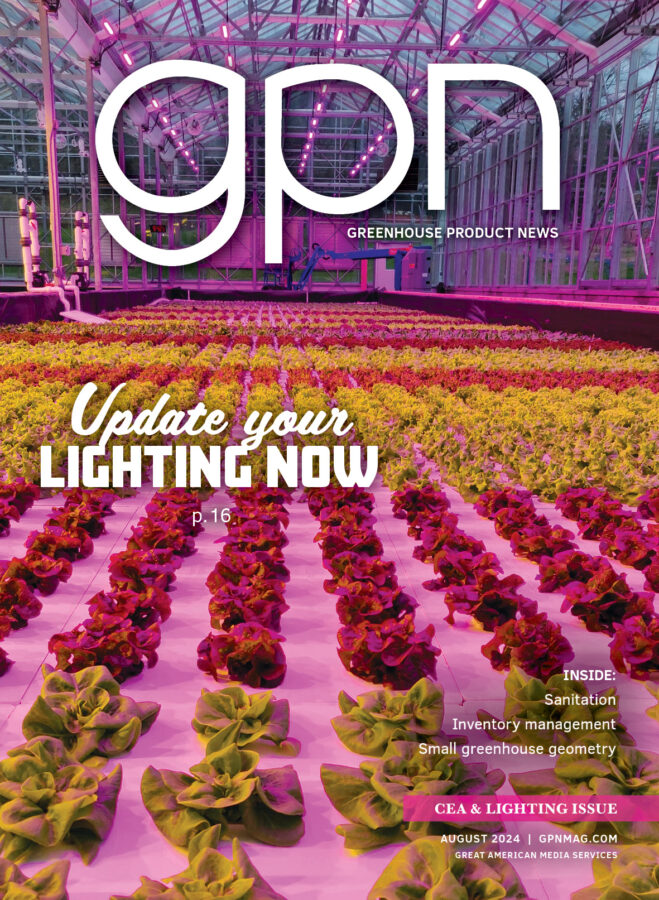
Duets: From rural farm to university

Today’s guest is Garrett Owen, Ph.D. Garrett joined the Department of Horticulture and Crop Science at Ohio State University in January of 2023.
Peter: Welcome to today’s discussion Garrett, thanks for joining me. Your career path is particularly wide and deep and will be fun to discuss. But first, tell us about your three-way appointment at Ohio State.
Garrett: I’m an assistant professor and Extension specialist in the Department of Horticulture and Crop Science at The Ohio State University focused on sustainable greenhouse and nursery production systems. While I’m not teaching yet, I plan to offer a course on floriculture crop production and one nursery crops. I’m the co-advisor (along with Chieri Kubota, Ph.D.) for the controlled environment agriculture (CEA) minor that is now available.
While the majority of my appointment is Extension, I’m working on a statewide needs assessment — getting out and visiting growers and Extension offices to learn about the breadth of the Ohio greenhouse and nursery industries. My research program is focused on plant growth regulation, plant nutrition (fertility, water quality, and substrates and alternatives) and crop production and environments. In general, the goal of my program is to provide growers relative and timely information to produce high-quality, marketable ornamental crops. None of this would be possible without my graduate students and industry partnerships.
Peter: I can relate to several of your experiences so let’s discuss how you walked the path you did. Begin with your early years and how you became interested in plants, gardening and horticulture.
Garrett: I grew up in a small farming community in Rowan County, North Carolina, where my love for greenhouse production started in high school. As a sophomore, I enrolled in the Horticulture 1 class, which covered plant propagation methods, crop production, plant maintenance and more. The most impactful part of the class was the hands-on experience working in the greenhouse growing pansies, Boston ferns and poinsettias. I was intrigued with production and fascinated by rooting cuttings of tradescantia for spring hanging baskets sales.
Peter: I’ll compare our high school experiences to show how different opportunities can lead to similar outcomes. I grew up on a family farm and greenhouse operation but my high school course offerings in plants, in the early 1970s, were … zero. It’s very satisfying to hear that horticulture is being promoted as a career path at the high school for your generation, that’s wonderful.
Garrett: While enrolled in the class, I joined the National Future Farmers of America (FFA) organization. We were required to initiate a supervised agriculture experience (SAE). I recall discussing the SAE with my parents, and with their support, embarked on a journey of starting my own greenhouse business. From high school until I graduated with my masters of science degree, I owned and operated Owen’s Greenhouse and Nursery.
After high school, I attended North Carolina State University (NC State) where I started in agriculture education but switched to horticulture science about halfway through my first semester. As an undergraduate student, I worked for the NC State Bramble Breeding Program, served as a teaching assistant and interned at Rockwell Farms in Rockwell, North Carolina. Through these experiences, I learned that I wanted to pursue a higher education beyond a bachelor’s degree and help growers.
I stayed at NC State and joined Brian Jackson’s lab in 2011 investigating pine wood chips as an alternative to perlite in greenhouse substrates. After defending my masters of science, I worked for Brian Whipker until graduation. I was also fortunate to join him on Extension visits throughout North Carolina and participate in the National Floriculture Forum in New Hampshire. Peter, this is where we originally met in 2013.
Peter: Another page out of the “it’s a small industry” book, Garrett. Hosting the group at the end of your day of touring remains a favorite memory of mine. It was a career marker for me to have colleagues, industry experts, and graduate students viewing research and socializing in my greenhouse.
Garrett: After graduating from NC State, I spent the summer back home and prepared to move to West Lafayette, Indiana, where I joined Roberto Lopez’s lab at Purdue University as a full-time research technician and part-time doctoral student. My doctoral research focused on optimizing root-zone temperature and daily light integral to callus and root vegetative shoot tip cuttings of herbaceous perennials. I enjoyed my time under the direction of Dr. Lopez where I had the opportunity to conduct research under field, high tunnel, double-poly and glass- covered greenhouses, and walk-in growth chambers on several ornamental and food crops. He provided many opportunities to travel throughout Indiana on Extension visits, e-GRO tours, grower meetings and present at national and international meetings.
Peter: It’s no surprise that your work with Brian Jackson, Brian Whipker and Roberto Lopez introduced you to the Extension side of our university programs. The three of them share a commitment of engaging directly with commercial growers through their programs.
I know you recognize this as a very special opportunity and, no doubt, it is precisely why you chose these programs and graduate advisors to learn from. My perspective remains ‘old school’ and anchored in the belief that visiting growers in their greenhouses shows a commitment that they appreciate. I’ve been on both sides of this street and believe it to be true. Sure, we can up our efficiency with electronic extension work but sometimes it’s still the gold standard to stand with a grower in his or her greenhouse to exchange ideas.
Garrett: After earning my doctorate in 2017, I joined the Department of Horticulture at Michigan State University (MSU) as the Eastern Michigan greenhouse and controlled environment outreach specialist with a split between 85% Extension and 15% research. I was located off-campus at the MSU Tollgate Farm and Education Center in Novi, Michigan, where I conducted research and held grower meetings. I spent most of my time visiting, assisting and educating, yet learning, from many of the Southeastern Michigan and Metro Detroit Flower Growers.
In spring 2020, I joined the Department of Horticulture at the University of Kentucky (UK) as an assistant Extension professor of greenhouses and controlled environments with a split between 65% Extension, 25% research, 10% instruction and 5% service. During my time at UK, I had the opportunity to develop courses and teach, broaden my research capacity to include nursery crops and hydroponic high-wire crops and leafy greens, and focus on Extension initiatives.
In January 2023, I joined the Department of Horticulture and Crop Science at The Ohio State University as an assistant professor for sustainable greenhouse and nursery production systems with a split between 50% Extension, 30% research, and 20% instruction.
Peter: That’s an impressive resume Garrett, hearing about your path after grad school brings to mind how many of us navigate our homeowning stage of life. Starter home first, then move up to something that fits better, and finally, finding a forever home to settle into. As a very partial Buckeye after my graduate school experience at Ohio State just a quick minute ago I hope your new address feels right as your forever career home. Given your extension responsibilities, what plans can you share for helping growers in Ohio and beyond?
Garrett: To date, I help coordinate e-GRO (Electronic Grower Resources Online), which is an online resource for growers of all sizes and commodities. e-GRO is a collaborative effort of floriculture and CEA specialists that provides alerts and blog posts about disease, insect, environmental, physiological and nutritional disorders being observed in commercial greenhouses. Alerts and blogs are shared weekly throughout the spring and then provided monthly during the summer into the winter. We also provide research reports, webinars, online mobile tools such as FertCalc, AlkCalc, PGRMix Master, Nutritional Monitoring Advisor and so on. We also maintain a YouTube channel with invaluable information from many of the industry experts.
Another Extension initiative that I’m passionate about is Fert, Dirt and Squirt: Nutritional Monitoring of Greenhouse Crops. This is a partnership with e-GRO but a portal focused on plant nutrition. On this website, crop-specific nutritional monitoring factsheets, guides, videos and an all-in-one book is available. The nutritional monitoring factsheets are interesting because they provide a crop-specific photographic guide to high and low substrate pH and electrical conductivity (EC) disorders, description of disorders, fertility regimens, crop-specific leaf tissue nutrient values and methods to monitor and correct disorders related to pH and EC.
Many of the crops reported are from grower inquiries, popular crops or from research supported by the American Floral Endowment. Like I mentioned before, there is an online mobile tool available called, Nutritional Monitoring Advisor. This tool allows growers to search by scientific name to determine optimal substrate pH and EC values determined by the PourThru, Saturated Media Extraction (SME) and 1:2 dilution methods. In addition, step-by-step guides and corrective procedures are available.
Again, both websites are extremely useful resources for growers of all sizes and commodities and educators (middle to high school teachers and Extension educators/agents) with new information being added weekly. Finally, I would like to thank the American Floral Endowment and Fred C. Gloeckner Foundation for supporting the creation of the website and tools/applications available.
Peter: Thank you for your time Garrett, it’s important for us to share career path experiences to celebrate the diverse angles through which individuals enter this fine industry.
For an enhanced reading experience, view this article in our digital edition by clicking here.


 Video Library
Video Library 



















